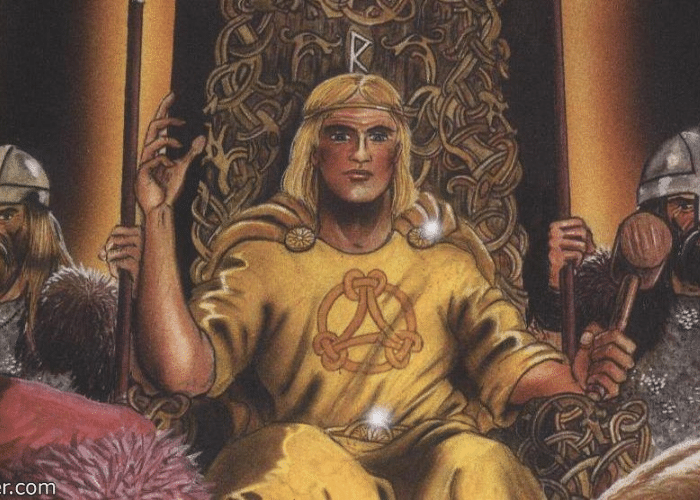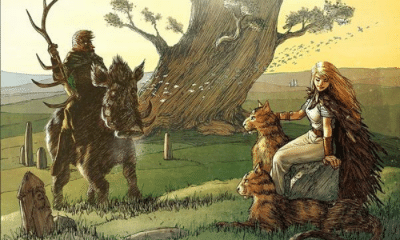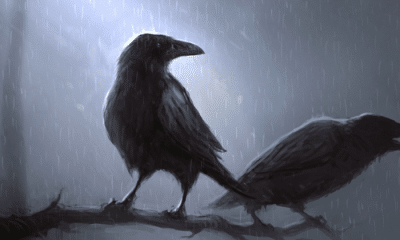
Norse
Forseti: The Norse God of Justice
Forseti: The Norse God of Justice
Forseti is usually called a god of law and justice in Nose mythology? Is there any truth in this interpretation, though?
Because few written sources survive from the era, much of our understanding of Norse mythology comes from only a few stories. There are gods and events that are mentioned only a few times, so little is truly known about them.
One of these is Forseti, whose name appears only twice in Norse-language sources. He has no myths of his own and does not play an active role in any stories.
The interpretation of Forseti as a god of law comes largely from the linguistic roots of his name as a single line from the Poetic Edda. Other explanations, however, make it seem likely that Forseti was not a native Norse god at all.
The Two Mentions of Forseti
Unfortunately for modern readers, Forseti is only mentioned twice in Old Norse sources.
The first mention of the god is in the Poetic Edda. This is only a brief appearance, however.
While the stories of the Poetic Edda were compiled from several original sources, Grímnismál is often considered to be one of the oldest. It is thought to have first been written in the 10th century, although some historians believe that some sections were added two or three hundred years later.
This poem is the only written reference to Forseti that may be from the Viking Age.
In a listing of the halls that the gods live in, the fifteenth stanza says that Forseti lives in a magnificent place called Glitnir. Meaning “Gleaming,” the name seems fitting since the poem describes the gold and silver pillars that the hall is built upon.
The Poetic Edda goes on to say that Forseti spends most days in Glitnir. There, he allays every strife.
The second surviving reference to Forseti is more informative, but many historians consider it to be more problematic as well.
Snorri Sturluson’s Prose Edda is one of the most complete and comprehensive works of Old Norse literature, particularly mythology. Unfortunately, however, it was not written until a later date so some of its stories have been called into question.
Forseti is mentioned in the Prose Edda, although he still does not play a major role in any of the myths.
Snorri Sturluson says that Forseti is the son of Baldur and his wife, Nanna. It gives no other information about him, however.
The only other possible reference to the god comes from an English writer. Alcuin of York was an 8th century scholar who was one of the leading theologians and teachers in the court of Charlemagne.
In his account of the life of Saint Willibrord, Alcuin describes the holy man visiting a place that may have once been connected to the worship of Forseti.
On an island between Denmark and Frisia, Willibrord met people who gathered their water from a holy spring. They did so in silence, Alcuin claims, out of respect for their god.
Alcuin calls the island Fositesland and says that it was named after the god of the spring. Both the location and the similar names suggest that the god mentioned may have been a version of Forseti.
With such sparse knowledge of the god’s existence, there is very little for historians to make claims about what domains Forseti may have ruled over. Some theories, however, have been largely accepted.
My Modern Interpretation
The first clue in interpreting Forseti’s role in the Norse pantheon is in his name.
Forseti is an Old Norse name that can be translated as “the presiding one.” In modern Icelandic and Faroese, the languages most closely related to that of the Viking Age, it is still used to mean “president.”
This, combined with the Poetic Edda’s description of Forseti as one who puts an end to strife has led most historians to describe him as a god of justice.
While popular portrayals focus on the strength and aggression of Viking Age leaders, their concept of the law also played an important role in their political affairs. Some historians believe that Forseti may have been seen as the divine counterpart of an important political position.
During the Viking Age, the people of Scandinavia developed a type of democratic government. Free men assembled at the Þing to settle disputes and amend their laws.
Like many early forms of participatory government, low-ranking members of society and women were not allowed to take part in the Þing. Women seem to have been accepted in some cases, however, when they acted as representatives for male relatives who were unable to attend the assembly.
While documentation of how the Þing was run is rare, and it is likely that different regions had their own rules and rituals, a logsogumadr, or “lawspeaker,” often presided over the event. As the ceremonial head of the Þing, it was his job to mediate and perhaps declare final judgment.
Forseti may have been a divine form of the law speaker. His role was similarly to oversee the law by mediating disputes and putting an end to disagreement.
This may also be why he was connected to Baldur.
Snorri Sturluson described Forseti as the beloved god’s son, although some scholars have doubts about this relationship.
The Prose Edda often clarifies and simplifies events and relationships between the gods to create a more cohesive story, leading some to think that the familial relationship may have been invented for the sake of tidiness rather than as part of an older tradition.
Still, Sturluson did not make the connection arbitrarily. In the Poetic Edda, Forseti’s home is described as gleaming in a way that is also often connected to Baldur.
The 8th century description of Fositesland, however, throws much of this into doubt.
The island is usually identified as modern Heligoland, an archipelago that is now part of Germany. Its name comes from a word for “holy,” likely reflecting an early association with an important god.
The population of Heligoland remains ethnically Frisian, taking their name from an ancient tribe described in Roman accounts. By the 8th century, the descendants of this ancient Germanic tribe had intermarried with Angles and Saxons who settled the area.
The Frisians, therefore, had a culture and religion that were related to, but not identical to, those of the Norse people who lived nearby. The naming of Fositesland indicates that their local god was likely related to Forseti, but it is uncertain.
The differences between their names may be minor, but to linguists, they could indicate a radical change in meaning.
The name Fosite could have been a local variation or even a mistake made in transcription. But if the Frisian god was the same as the Norse one, it could also mean that the common translation of his name is inexact.
Some scholars have pointed to the importance of the spring in the story of Fositesland as a possible alternative for the god’s origins. They believe that Forseti is a later name, likely based on folk etymology with the word forseti, and that Fosite originally had a different meaning.
Linguistically, the name may be related to that of Poseidon. He was brought to the area by Greek traders, who are known to have visited the area as early as 325 BC, as a god of water.
Over time, contact with the Frisians introduced the character into Norse mythology. The similarities between his name and words relating to the law in their language gave him added attributes that led to him being seen as a god of justice.
This would explain why Forseti does not feature in narrative myths or, outside of Sturluson’s later mention, have a strong connection to the other gods. Because he was not a native Norse god, older stories of him did not exist.
An outside origin could also explain why there is no mention of Forseti in Roman sources.
While the Romans did not directly come into contact with the Norse, they did have contact with the Frisians. Although Saxo Germanicus documented other gods of the Frisians in some detail, he never mentioned one by the name of Forseti or Fosite.
Some historians believe that the god’s cult may have been local to Heligoland and only spread to the north, toward Scandinavia and outside of the Roman sphere of influence. Rather than being a well-known Frisian god, Fosite’s worship was limited to the islands that, due to their proximity to Denmark, were also in closest contact with what would become Norse culture.
In Summary
The god Forseti is only mentioned in two Old Norse sources.
The Poetic Edda describes his gold-covered hall and says he puts an end to discord. The Prose Edda names him as a son of Baldur, although historians doubt whether this was a widely-held belief or an invention of the author.
Because his name is related to the Norse word for a president, he is often interpreted as a divine representation of a judge or mediator. This role would have played a part in the Þing, the Viking Age assembly that settled disputes and wrote new laws.
This interpretation is cast into doubt, however, by more than a lack of textual evidence. A possibly related god from a nearby island chain could provide another origin for Forseti.
A Christian writer from the 9th century claimed the people of an island called Fositesland showed particular reverence to a holy spring. Some historians believe that Fosite may have been the Frisian version of Forseti.
If this is the case, it is possible that the name is a regional variation or mistake in transcription. It could also, however, show that the god was not native to the area.
Some believe that Fosite was a water god, brought to the region by Greek sailors who worshipped Poseidon. From the islands, he was eventually taken to nearby Denmark and into Norse culture.
Forseti’s name could, therefore, be a later change. The one-time water god became a god of law because his name sounded similar to an existing word.
Rather than proving his original function, Forseti’s name could be evidence that he was one of the last gods to be added into the Norse pantheon.









